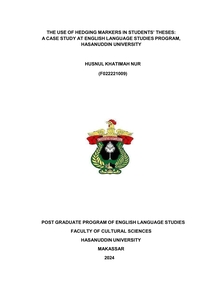Khatimah Nur, Husnul (2025) The Use of Hedging Markers in Students' Theses: A Case Study at English Language Studies Program, Hasanuddin University. Thesis thesis, UNIVERSITAS HASANNUDDIN.
![[thumbnail of Cover]](/42956/2.hassmallThumbnailVersion/F022221009_tesis_08-08-2024%20cover1.jpg)

F022221009_tesis_08-08-2024 cover1.jpg
Download (249kB) | Preview
F022221009_tesis_08-08-2024 bab I-II.pdf
Download (1MB)
F022221009_tesis_08-08-2024 dp.pdf
Download (1MB)
F022221009_tesis_08-08-2024.pdf
Restricted to Repository staff only until 2 August 2027.
Download (3MB)
Abstract (Abstrak)
This study was aimed to explore the utilization of hedging markers in theses written by
English Language Studies (ELS) students, with specific objectives to identify common
types of hedging markers used, determine the dominant hedging marker types, and
assess the students' familiarity with hedging in academic writing. Employing a
qualitative descriptive methodology, this research utilized the AntConc application to
analyze the hedging markers within a corpus of ELS theses. Data were gathered
through observation, document analysis, and interviews to offer a comprehensive
understanding of hedging practices among ELS students. The findings revealed that
students predominantly employed four types of hedging strategies as identified by Ken
Hyland (1996): attribute, reliability, writer-oriented, and reader-oriented hedges. The
analysis showed that students preferred using attribute and reliability hedges. This
means they often made statements that could be true, but not definitely. This preference
shows that students were somewhat unsure about their arguments. Reliability hedges,
in particular, showed that students had doubts about how accurate their statements
were. This strategy allows students avoid criticism by making statements that could be
true or false. On the other hand, using reader-focused hedging was the least popular,
showing it's an area ELS students could improve in their writing. The study also pointed
out students liked to use vague language on purpose, especially in attribute hedging,
and often used words that show uncertainty in reliability hedging.
| Item Type: | Thesis (Thesis) |
|---|---|
| Uncontrolled Keywords: | Studi Kasus, Studi bahasa inggris, hedging, penulisan akademik |
| Subjects: | P Language and Literature > PE English |
| Divisions (Program Studi): | Fakultas Ilmu Budaya > Bahasa Inggris |
| Depositing User: | Unnamed user with username pkl2 |
| Date Deposited: | 06 Mar 2025 01:44 |
| Last Modified: | 06 Mar 2025 01:44 |
| URI: | http://repository.unhas.ac.id:443/id/eprint/42956 |


